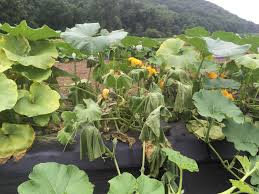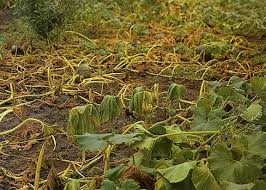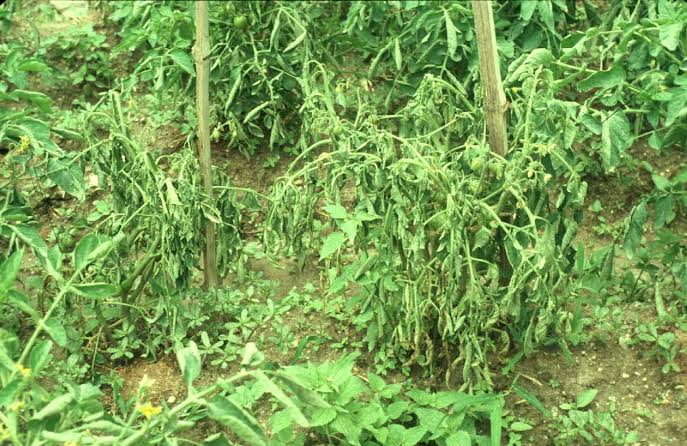Bacterial wilt, such as bacterial wilt of tomatoes, is a plant disease caused by the bacterium Ralstonia solanacearum. This destructive pathogen affects a wide range of plants, posing a significant threat to agricultural crops, with tomatoes being particularly susceptible.
The scientific name of the bacterium responsible for bacterial wilt of tomatoes is Ralstonia solanacearum. This bacterium has the ability to infiltrate the plant’s vascular system, leading to wilting and eventual death of the infected plant. The disease is known for its rapid spread, causing considerable economic losses in agricultural settings.
Bacterial wilt symptoms in tomatoes often begin with wilting of the lower leaves, progressing upwards through the plant. As the bacterium clogs the vascular tissues, it hinders the flow of water and nutrients, resulting in wilting and collapse of the entire plant. The wilted leaves may exhibit a characteristic wilting pattern, often referred to as “flagging.”
One of the challenges in managing bacterial wilt is the bacterium’s ability to survive in soil for extended periods. The pathogen can persist in infected plant debris, making crop rotation less effective as a control measure. Additionally, the bacterium can be transported through contaminated water, soil, or agricultural equipment, contributing to its widespread dissemination.
Cultural practices, such as selecting resistant tomato varieties and practicing proper sanitation, play a crucial role in managing bacterial wilt. Crop rotation, although not foolproof, can help reduce the pathogen’s population in the soil. It is essential for farmers to implement strict hygiene measures to prevent the unintentional spread of the bacterium from one field to another.
Chemical control methods, such as the use of bactericides, may offer some relief in managing bacterial wilt, but their efficacy can be limited. Moreover, excessive reliance on chemical solutions may lead to the development of resistant bacterial strains, further complicating control efforts.
Research continues to explore alternative strategies for managing bacterial wilt, including the development of resistant plant varieties through breeding programs and the use of biological control agents. These approaches aim to provide sustainable, environmentally friendly solutions to mitigate the impact of bacterial wilt on tomato crops and other susceptible plants.
However, bacterial wilt, exemplified by bacterial wilt of tomatoes caused by Ralstonia solanacearum, poses a significant threat to agriculture. The disease’s complex nature, coupled with its ability to persist in the environment, requires a multifaceted approach to management. As scientists and farmers collaborate, ongoing efforts seek to enhance our understanding of bacterial wilt and develop effective strategies to safeguard tomato crops and other vulnerable plants from its detrimental effects.
Read Also: Ordering Honey Bees: A Comprehensive Guide
Plants Affected by Bacterial Wilt (Ralstonia solanacearum)

Bacterial wilt is a plant disease that can affect a wide variety of host plants. In addition to tomatoes, which we previously discussed, here are some other plants that are commonly affected by bacterial wilt:
1. Potatoes (Solanum tuberosum): Potatoes, being part of the Solanaceae family like tomatoes, are susceptible to bacterial wilt caused by Ralstonia solanacearum. The bacterium can cause wilting, yellowing, and eventual death of potato plants.
2. Eggplants (Solanum melongena): Another member of the Solanaceae family, eggplants, can also fall victim to bacterial wilt. Symptoms include wilting, yellowing of leaves, and stunted growth.
3. Peppers (Capsicum spp.): Peppers, belonging to the same family as tomatoes and potatoes, are prone to bacterial wilt. Infected plants exhibit wilting, discoloration, and a decline in overall health.
4. Bananas (Musa spp.): Certain strains of Ralstonia solanacearum can affect banana plants, causing a wilt disease known as Moko disease. This bacterial wilt can lead to severe economic losses in banana plantations.
5. Tobacco (Nicotiana tabacum): Tobacco plants are also susceptible to bacterial wilt. Infected plants may display wilting, yellowing, and a decline in leaf quality.
6. Ginger (Zingiber officinale): Bacterial wilt can impact ginger plants, causing wilting of leaves and stems. This can lead to a reduction in ginger yield and quality.
7. Sweet Potatoes (Ipomoea batatas): Sweet potatoes can be affected by bacterial wilt, resulting in wilting and a decline in the overall health of the plants.
8. Cucumbers (Cucumis sativus): Although cucumbers are not as commonly affected as some other plants, they can still be susceptible to bacterial wilt. Symptoms include wilting, yellowing, and a general deterioration of the plant’s health.
It’s important for farmers and gardeners to be aware of the potential risk of bacterial wilt in various crops and to implement preventive measures and management strategies to minimize its impact on agricultural production.
Damages Caused by Bacterial Wilt

Bacterial wilt, such as bacterial wilt of tomatoes caused by Ralstonia solanacearum, can inflict severe damage on affected plants and lead to significant economic losses in agricultural settings. Here are the key damages caused by bacterial wilt:
1. Wilting and Desiccation: The most apparent and early symptom of bacterial wilt is wilting of the plant. The bacterium disrupts the plant’s vascular system, impeding the flow of water and nutrients. This results in a rapid wilting of leaves, initially affecting lower leaves and progressing upwards. As the disease advances, the entire plant may become desiccated and eventually die.
2. Yellowing of Leaves: Infected plants often exhibit yellowing of leaves, a condition known as chlorosis. This yellowing is due to the blockage of nutrient and water transport, leading to a lack of essential elements for normal plant function. The combination of wilting and yellowing contributes to a decline in overall plant vigor.
3. Stunted Growth: Bacterial wilt can cause stunted growth in affected plants. As the bacterium interferes with the plant’s ability to take up nutrients, the overall development of the plant is compromised. This can result in smaller and less productive crops, significantly impacting yield.
4. Reduced Fruit Quality and Yield: In the case of bacterial wilt of tomatoes, the disease can lead to reduced fruit quality and yield. Infected plants may produce smaller and fewer fruits, and the fruits themselves may show signs of decay, affecting market value and economic returns for farmers.
5. Root Rot: Bacterial wilt can lead to root rot, further exacerbating the plant’s decline. The bacterium may invade and damage the root system, hindering the plant’s ability to absorb water and nutrients from the soil.
6. Rapid Spread and Crop Losses: Bacterial wilt is known for its rapid spread, facilitated by contaminated soil, water, or agricultural equipment. Once established in a field, the disease can quickly escalate, causing widespread crop losses. This rapid dissemination makes control and containment challenging.
7. Long-Term Soil Contamination: The bacterium Ralstonia solanacearum can survive in soil for extended periods, even in the absence of susceptible host plants. This creates a long-term challenge for farmers, as the soil remains a potential source of infection for subsequent crops. Crop rotation may offer some relief, but complete eradication from the soil is often difficult.
8. Economic Impact: Bacterial wilt can have significant economic repercussions for farmers and the agricultural industry. Crop losses, decreased marketable yield, and the costs associated with disease management measures contribute to financial strain on affected agricultural systems.
Additionally, bacterial wilt causes a cascade of detrimental effects on plants, impacting their physiological processes, yield, and overall health. The ability of the bacterium to persist in the environment and its rapid spread make bacterial wilt a challenging and economically damaging plant disease.
Read Also: Best Flowers for Honey Bees
Control and Preventive Measures

Effective control and preventive measures are crucial in managing bacterial wilt, such as bacterial wilt of tomatoes caused by Ralstonia solanacearum. Here are key strategies to mitigate the impact of bacterial wilt:
1. Use Resistant Varieties: Planting resistant varieties is a fundamental strategy. Breeding programs have developed tomato cultivars with resistance to specific strains of Ralstonia solanacearum. Using resistant varieties can significantly reduce the risk of bacterial wilt.
2. Crop Rotation: Implementing a well-planned crop rotation strategy helps break the disease cycle. Avoid planting susceptible crops, including tomatoes and other Solanaceae family members, in the same field for consecutive seasons. This can reduce the buildup of the bacterium in the soil.
3. Soil Solarization: Soil solarization involves covering the soil with transparent plastic to capture solar heat, raising soil temperatures and reducing soilborne pathogens, including Ralstonia solanacearum. This practice can be effective in managing bacterial wilt.
4. Sanitation Practices: Maintain strict sanitation practices to prevent the spread of the bacterium. Thoroughly clean and disinfect equipment, tools, and machinery used in infested fields. Remove and destroy infected plant debris promptly to reduce the source of inoculum.
5. Water Management: Avoid over-irrigation, as excessive moisture creates favorable conditions for bacterial wilt. Use well-drained soils and adopt irrigation practices that minimize waterlogging. Consider using drip irrigation to reduce soil splash, which can spread the bacterium.
6. Biological Control: Explore biological control options, such as beneficial microorganisms that antagonize Ralstonia solanacearum. Biocontrol agents, like certain strains of bacteria or fungi, can help suppress the pathogen’s growth in the soil.
7. Chemical Treatments: While not always the first choice due to environmental concerns and potential development of resistance, some chemical treatments may offer short-term relief. Copper-based bactericides are one example, but their efficacy can vary, and they may need to be applied preventively.
8. Quarantine Measures: If bacterial wilt is identified in a specific area, consider implementing quarantine measures to prevent the movement of contaminated soil, plants, or equipment to uninfested areas. This helps contain the spread of the disease.
9. Early Detection and Removal: Regularly monitor crops for symptoms of bacterial wilt. Early detection allows for prompt removal and destruction of infected plants, reducing the chances of further spread. Isolate and dispose of affected plants away from healthy crops.
10. Education and Extension Services: Provide education and extension services to farmers, advising them on best practices for bacterial wilt management. Disseminate information about the disease, its symptoms, and recommended control measures to enhance awareness.
Adopting an integrated approach that combines several of these measures is often the most effective way to manage bacterial wilt. Strategies should be tailored to the specific crop and local conditions, considering the pathogen’s persistence in the soil and its ability to spread rapidly.
Frequently Asked Questions (FAQs) About Bacterial Wilt (Ralstonia solanacearum)
1. Q: What is bacterial wilt, and how does it affect tomatoes?
A: Bacterial wilt is a plant disease caused by the bacterium Ralstonia solanacearum. In tomatoes, the bacterium invades the vascular system, leading to wilting, yellowing of leaves, and a decline in overall plant health. It can result in significant crop losses.
2. Q: Which other crops are susceptible to bacterial wilt?
A: Besides tomatoes, crops such as potatoes, eggplants, peppers, bananas, tobacco, ginger, sweet potatoes, cucumbers, and others can be affected by bacterial wilt. The bacterium Ralstonia solanacearum has a broad host range.
3. Q: How does bacterial wilt spread?
A: Bacterial wilt can spread through contaminated soil, water, or agricultural equipment. The bacterium can survive in soil for extended periods, contributing to its persistence. Soil movement and irrigation water are common vectors for its dissemination.
4. Q: Are there resistant tomato varieties available?
A: Yes, breeding programs have developed tomato cultivars with resistance to specific strains of Ralstonia solanacearum. Using resistant varieties is a key preventive measure against bacterial wilt.
5. Q: What are the symptoms of bacterial wilt in tomatoes?
A: Symptoms include wilting of leaves, yellowing (chlorosis), stunted growth, and a decline in overall plant vigor. The disease often progresses rapidly, causing extensive damage to the plant.
6. Q: Can bacterial wilt be controlled with chemical treatments?
A: While some chemical treatments, like copper-based bactericides, may offer short-term relief, they are not always the most sustainable solution. Overreliance on chemicals can lead to the development of resistance, and their effectiveness can vary.
7. Q: How can farmers prevent bacterial wilt in their crops?
A: Prevention strategies include using resistant varieties, practicing crop rotation, adopting soil solarization, maintaining sanitation practices, implementing proper water management, exploring biological control options, and regularly monitoring crops for early detection and removal of infected plants.
8. Q: Can bacterial wilt be eradicated from the soil?
A: Complete eradication from the soil is challenging due to the bacterium’s ability to survive for extended periods. However, implementing proper sanitation, crop rotation, and other preventive measures can help reduce the pathogen’s population in the soil.
9. Q: What are the economic impacts of bacterial wilt on agriculture?
A: Bacterial wilt can lead to significant economic losses due to reduced crop yields, lower quality of produce, and the costs associated with disease management measures. The impact extends to both small-scale farmers and large agricultural operations.
10. Q: Is there ongoing research for better management of bacterial wilt?
A: Yes, research is ongoing to develop more effective management strategies for bacterial wilt. This includes breeding resistant varieties, exploring biological control methods, and understanding the genetic diversity of the bacterium to inform targeted control measures.
Read Also: What Are People Looking For in Online Fitness Classes?
